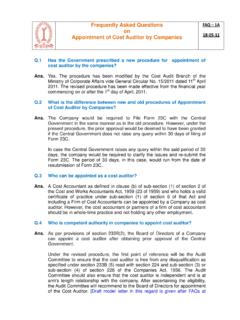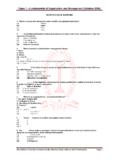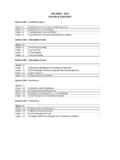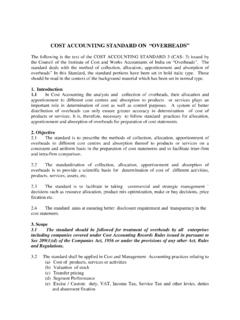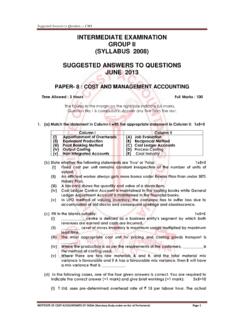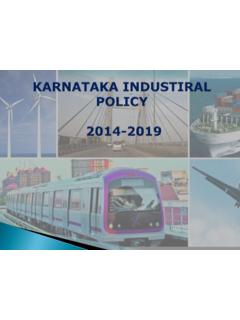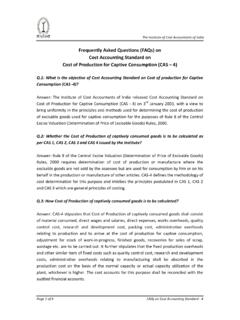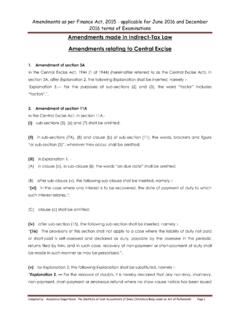Transcription of EXPOSURE DRAFT Guidance Note on Internal …
1 Date: 12th August 2013 Last date for submission of views/ comments/ suggestions extended upto 23rd August 2013 On EXPOSURE DRAFT Guidance Note on Internal audit of Pharmaceutical Industry Please submit your views/ comments/ suggestions preferably by email at or latest by August 23, 2013. Comments should be addressed to: CMA Budhiraja Director (Professional Development) and Secretary to Professional Development Committee The Institute of Cost Accountants of India, CMA Bhawan, 3rd Floor, 3, Lodhi Road, Institutional Area, New Delhi- 110003 Email: Date: 26th July 2013 EXPOSURE DRAFT Guidance Note on Internal audit of Pharmaceutical Industry The following is the EXPOSURE DRAFT of Guidance Note on Internal audit of Pharmaceutical Industry issued by the Professional Development Committee of the Institute of Cost Accountants of India, for comments and suggestions.
2 The comments/ suggestions on any aspect of this EXPOSURE DRAFT would be most helpful if they indicate the specific paragraph or group of paragraphs including page number to which they relate, also contain a clear rationale and, where applicable, provide a suggestion for alternative wording. The proposed Guidance Note may be modified in light of comments/ suggestions received before the same being issued as Guidance Note on Internal audit of Pharmaceutical Industry. Please submit your views/ comments/ suggestions preferably by email at or latest by August 11, 2013. Comments should be addressed to: CMA Budhiraja Director (Professional Development) and Secretary to Professional Development Committee The Institute of Cost Accountants of India, CMA Bhawan, 3rd Floor, 3, Lodhi Road, Institutional Area, New Delhi- 110003 Email: EXPOSURE DRAFT Guidance NOTE ON Internal audit OF PHARMACEUTICAL INDUSTRY LAST DATE FOR COMMENTS: AUGUST 11, 2013 PROFESSIONAL DEVELOPMENT COMMITTEE HQ: CMA Bhawan, 12, Sudder Street, Kolkata-700 016 Delhi Office.
3 CMA Bhawan, 3, Institutional Area, Lodhi Road, New Delhi-110003 INDEX OF CONTENTS Chapter Description Page No 1 Introduction to Internal audit 1 History and Evolution of Internal audit 1 Definition 2 Necessity 3 Objectives 5 Principles 6 Strategy 9 Approaches 13 Terms of Engagement 17 Independence 20 Pronouncements 21 2 Documentation and Working Papers 23 3 Planning an Internal audit and audit Programme 28 4 audit Sampling 33 5 audit Evidence 37 6 Analytical Procedures 39 7 Accounting System and Internal Control 42 8 Control and Risk Assessment 45 9 Internal audit in ERP Environment and Systems audit 51 10 Relying on External Opinion and Reference of Auditor Expert 55 11 audit Conclusion and Corrective Measures 57 12 Report Writing and audit Report 60 13 Introduction to Pharmaceutical
4 Industry 63 14 Applicable Government Policies and Rules 65 15 Legal and Regulatory Framework 68 16 Technical Peculiarities 71 17 Special transactions peculiar to the industry 73 18 Activities/ Services of the industry 75 19 audit of Operational Activities 77 20 audit of Special Areas with reference to peculiar transactions 83 21 audit of Functional Areas 86 22 Cost audit specific to the Industry 91 23 audit follow-up 97 24 Checklist 100 The Institute of Cost Accountants of India 1 Chapter 1: Introduction to Internal audit History and Evolution of Internal audit Definition Necessity Objectives Principles Strategy Approaches Terms of Engagement Independence Pronouncements HISTORY AND EVOLUTION OF Internal audit The establishment of Internal audit can be linked to the need of independent verification with a view of reducing book keeping errors, general misappropriations and fraud.
5 The systematic verification of records and evidence started being called Internal audit . It was felt that external audit at the end of the year needed to be supplemented by more frequent verification and it was equally important to review and upgrade the process and procedure of carrying out Internal audit With the booming growth of business size and structure, it was felt that many businesses did not have appropriate controls in place to permit full achievement of their strategic objectives. The management of these businesses found it impossible to visually supervise all of the operating areas in their respective field of responsibility or to have sufficient personal contact with individuals, who directly or indirectly reported to them. In seeking ways to deal with these new problems, management appointed special staff people to review and report on what was happening and to probe for the why.
6 These people came to be known as " Internal auditors." The Internal audit function varied greatly as to the number of people assigned to perform it and in the scope and nature of the work being done. In some organisations, Internal auditors were used to check on routine financial and operational activities with a heavy emphasis on compliance, security, and detection of fraud. In others, Internal auditors were given higher levels of status and were asked to analyse and appraise more substantive financial and operational activities. Gradually, Internal auditors also began to exhibit industry specialisation in terms of their domain knowledge of specific industries such as health-care, oil, gas, and energy, defense, financial services, transportation, wholesale and retail, technology, media and entertainment, telecommunications, government, non-profits and education, etc.
7 Companies worldwide have witnessed rapid and radical change with organization and industry wide significance. The response of company management to such aggressive global competition has led to an increase in multitudes of the quality (efforts such as six sigma) and risk management The Institute of Cost Accountants of India 2 initiatives, re-engineered structures and procedures, and enhanced responsibility all based on the ever increasing need for more timely, reliable, and relevant management information. This has also led to a rats race between global organizations to implement effective and efficient corporate governance processes.
8 Thus, to no one s amazement the Internal audit function is now being viewed as a qualified group of professionals who help with such experimentation with global corporate governance while supporting key governance processes of monitoring control mechanisms and ascertaining operational performance. However, to facilitate this escalation in the demand for their services, not only do Internal auditors need to obtain and display considerably enhanced set of skills and competencies but they also need to exhibit industry specialisation and EXPOSURE to a varied operating specialties within the industry. With the recent advents of increase in scope and acceptability Cost audit and Compliance Report, CMAs are in perfect position to demonstrate the requisite skills and competencies necessary for undertaking successful Internal audit function including risk evaluation and risk management.
9 DEFINITION OF Internal audit The Chartered Institute of Management Accountants, UK (CIMA) defines Internal audit as: An independent appraisal activity established within an organisation as a service to it. It is a control which functions by examining and evaluating the adequacy and effectiveness of other controls; a management tool which analyses the effectiveness of all parts of an organisation s operations and management. The Institute of Internal Auditors (IIA) also defines Internal audit on similar lines as: Internal auditing is an independent, objective assurance and consulting activity designed to add value and improve an organisation's operations. It helps an organisation accomplish its objectives by bringing a systematic, disciplined approach to evaluate and improve the effectiveness of risk management, control, and governance processes.
10 These definitions state two clear functions of the Internal audit activity namely; Internal Control: Internal controls direct, monitor, and measures the company's resources and help to detect and prevent fraud from occurring within an organisation. It can be defined as a process which is performed by the employees of the company as well as the information technology systems that are used to assist the company in achieving its objectives. The management of a company is responsible for establishing the system of Internal controls within the organisation, but Internal auditors test the controls to make sure they are working effectively. Management Tool: Internal audit has been used as a management tool which monitors and evaluates the effectiveness of operational processes and risk management of a company.

